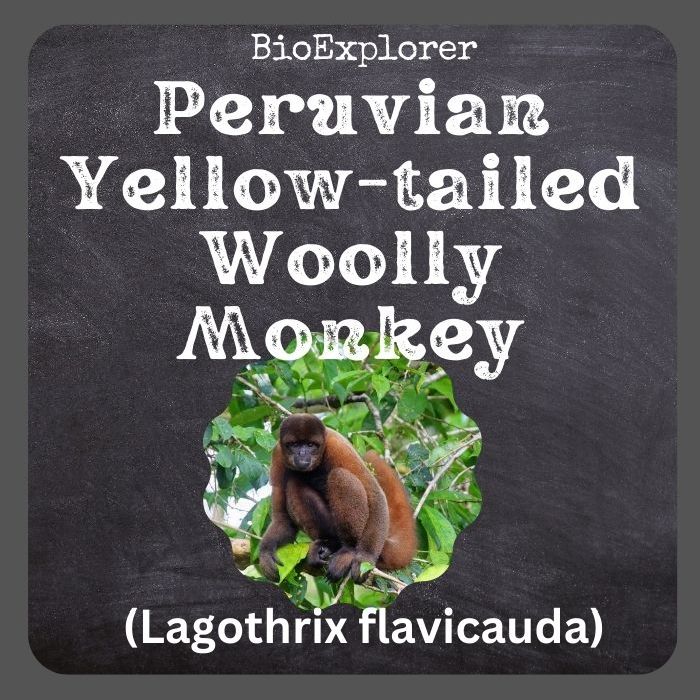
| Animalia | Primates | Atelidae | Lagothrix | Lagothrix flavicauda |

- Common Name: Peruvian Yellow-tailed Woolly Monkey
- Taxonomy Classification Year: 1812
- Monkey Size: 51.3 to 53.5 cm (20.2 to 21.06 in)
- Skin Color(s): Deep mahogany and copper
- Habitat: Cloud forest, mountain
- Diet: Omnivorous
- Native Countries: Peru
Peruvian Yellow-tailed Woolly Monkey Distribution
Peruvian Yellow-tailed Woolly Monkey Characteristics
The Peruvian yellow-tailed woolly monkey[1] (Lagothrix flavicauda), also called the yellow-tailed woolly monkey, is a New World Monkey native to Peru.
- It is a rare primate species found only in the Peruvian Andes, in the departments of Amazonas and San Martín, and in the adjacent areas of La Libertad, Loreto, and Huánuco.
- Peruvian yellow-tailed woolly monkey is among the rarest Neotropical primates and one of the largest mammals endemic to Peru.
- The length of the head and body of an adult can vary from 51.3 to 53.5 cm, and the tail is even longer than the body, reaching up to 63 cm (25 in).
- The average weight of adults is 8 kg, but some males reach 11.5 kg.
- The fur of the yellow-tailed woolly monkey is longer and denser than other woolly monkeys, an adaptation to the cold montane forest habitat.
- The monkey’s color is dark mahogany and copper, with a whitish patch on the muzzle extending from the chin to between the eyes.
- Its fur becomes darker towards the top of the body, so the head appears almost black.
- It has a strong prehensile tail with a hairless patch on the underside and yellowish fur on the last third of the tail, giving this species its name.
Suggested Reading: Woolly Mammoth Cloning
Peruvian Yellow-Tailed Woolly Monkey Facts
- Peruvian yellow-tailed woolly monkeys live in large social groups (about 23 individuals) of males and females.
- They have low reproductive rates and long intervals between births, contributing to their vulnerability to extinction.
- They have been known to display aggressive behavior on first encounters, such as branch shaking, short barking calls, and “mooning” their scrotal tuft.
- Peruvian yellow-tailed woolly monkeys engage in the consumption of soil, a phenomenon known as geophagy.
- They have a wide range of vocalizations, including a loud “puppy-like” bark that they use as an alarm or territorial call.
Suggested Reading: All Monkey Breeds
Cite This Page
APA7MLA8Chicago
BioExplorer.net. (2025, May 28). Peruvian Yellow-tailed Woolly Monkey. Bio Explorer. https://www.bioexplorer.net/animals/mammals/monkeys/peruvian-yellow-tailed-woolly-monkey/.
BioExplorer.net. "Peruvian Yellow-tailed Woolly Monkey" Bio Explorer, 28 May 2025, https://www.bioexplorer.net/animals/mammals/monkeys/peruvian-yellow-tailed-woolly-monkey/.
BioExplorer.net. "Peruvian Yellow-tailed Woolly Monkey" Bio Explorer, May 28 2025. https://www.bioexplorer.net/animals/mammals/monkeys/peruvian-yellow-tailed-woolly-monkey/.











